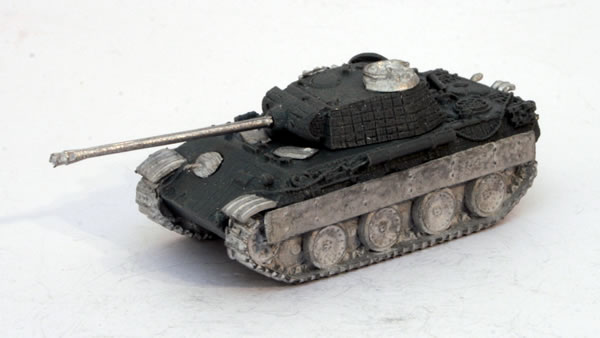Panther is the common name of a medium tank fielded by Nazi Germany in World War II that served from mid-1943 to the end of the European war in 1945. It was intended as a counter to the T-34, and to replace the Panzer III and Panzer IV; while never replacing the latter, it served alongside it as well as the heavier Tiger tanks until the end of the war. The Panther’s excellent combination of firepower, mobility, and protection served as a benchmark for other nations’ late war and immediate post-war tank designs, and it is frequently regarded as one of the best tank designs of World War II.
I bought this box set as it was available at Hobbycraft for a much cheaper price than the list price.
The resin and metal certainly fills the box.
There are five Panthers in the box and the hulls and turrets are in resin.
The tracks and the rest of the gubbinz are in metal. There are quite a few parts to the model and there are opportunities to customise each model futher. What’s nice about this pack is that each of the models is individually sculptured so there are subtle differences between each of the tanks. The parts include the tracks, mudguards, the cupola with an option to put in a tank commander, the front MG, exhausts, skirts and the main weapon.
The first stage was to wash the resin to get rid of any mould lubricant.
These are clean castings and the detail is very good, the Panthers for example have the Zimmeritt paste and you can see how the where it has “chipped off” has been modelled onto the hull.
Each of the castings is different, with this one there are spare tracks attached to the turret as extra armour.
They are very clean castings and the small piece of flash on the turret with this model was basically all that needed to be cleaned off.
The castings needed mininal cleaning before the next stage of constructing the models.
I then started the construction process, first by gluing the tracks onto the hull. Then adding the extra components of which there is a fair few.
One of the Panthers is going to be my command vehicle and so I have modelled it with the tank commander in the cupola.
I will also be leaving the “skirts” off, in the assumption that they have been lost in combat and have not yet been replaced. This will also differentiate the tank from the others in the platoon.
The following pictures show the finished Panthers before they are undercoated.
I found fitting the front mudguards the most challenging part of the model, it wasn’t easy to fit them flush and in the right position. I decided not to model any of the Panthers without them, as was shown on the box.
For the command vehicle I added some extra stowage from the Panzergrenadiers Headquarters pack.
For this vehicle I also kept the armoured skirts off.
For the others I either used the full armoured skirt or cut them down to represent battle damage.
Some of the models come with “extra armour” in terms of road wheels and spare tracks. Sometimes this is sculptured on to the turret or hull. I added additional “extra armour” to some of the models.
I added some extra stowage from the Panzergrenadiers Headquarters pack.
The next stage was a light white undercoat, making the models ready for the basecoat.
This is the command vehicle.
Having given the models a white undercoat, I then sprayed the underneath of the models with a Humbrol Dark Brown spray to add shadow when I apply the final basecoat of Flames of War Warpaint Late War German Armour.
I then applied a basecoat of Flames of War Warpaint Late War German Armour. This is the command tank.
All five Panthers together.
One of the Panthers next to a Tiger IE.
































































